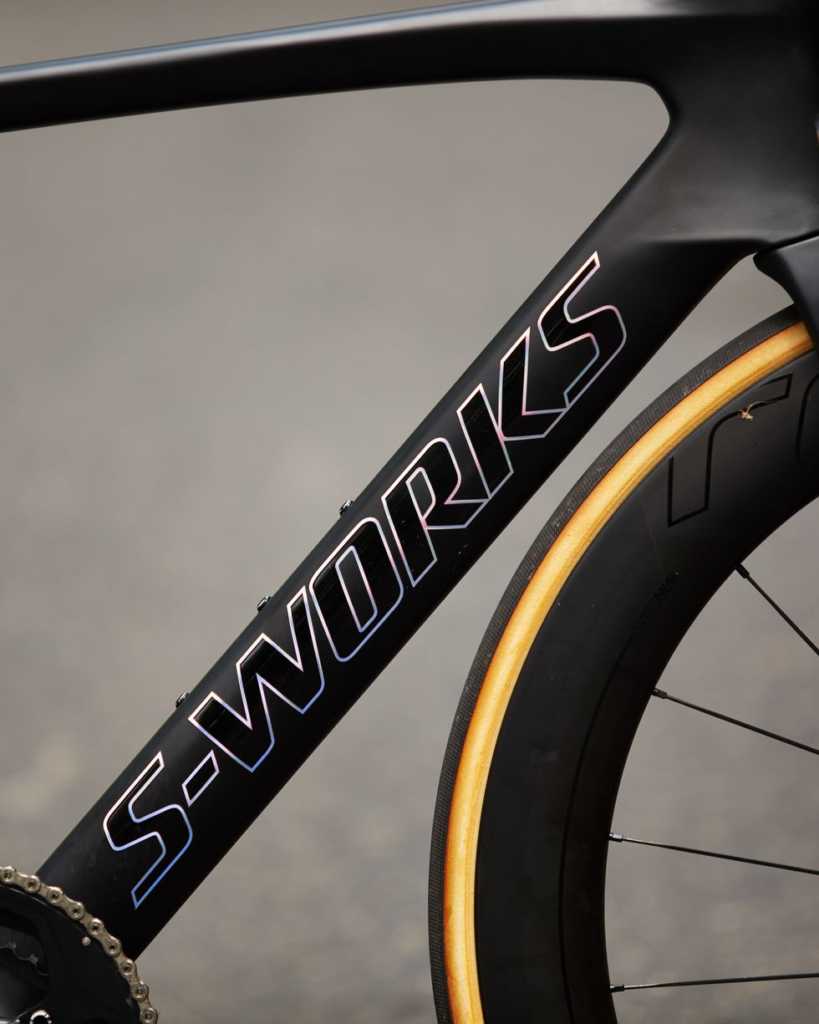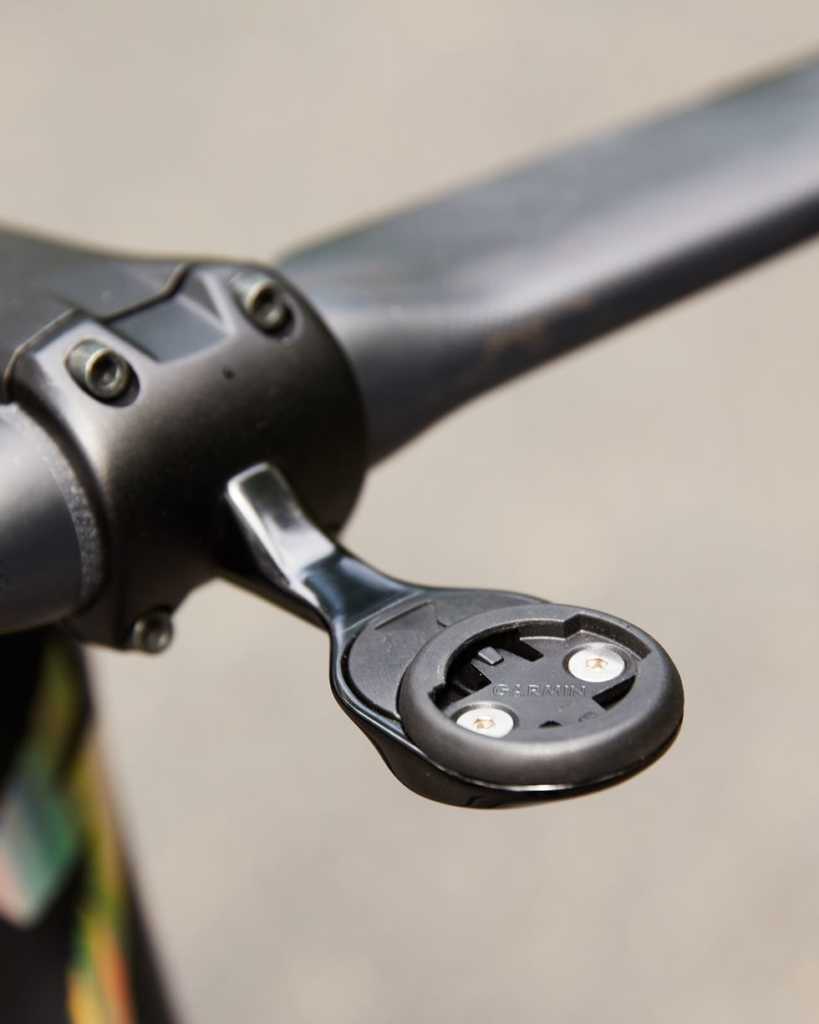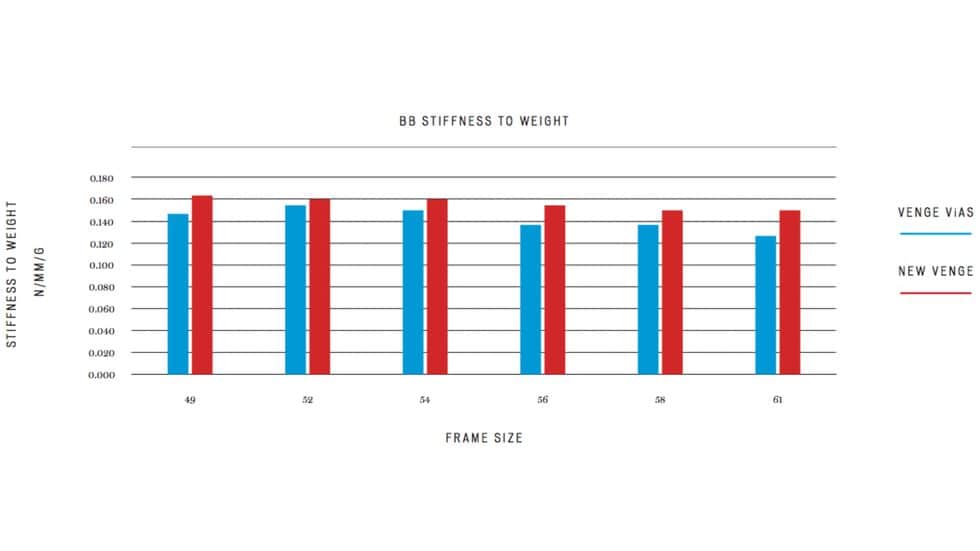Specialized Venge: Lighter, Faster, Smoother & Simpler
Specialized has released the third generation of one of the most well-known aero bikes: the Venge.
Over the past five-to-seven years, aerodynamics has been arguably the most prominent trend in road equipment. Aeroification has touched everything: fit, frames, handlebars, helmets, clothing, shoes, wheels, tyres – even cranks, chainrings, and pedals. The human body is no exception: hairy legs versus shaved legs; beard versus no beard, it’s all been tested in the wind tunnel. Even non-aero bikes are getting small tweaks to help them cut through the air a bit faster.
Given the influence of aerodynamics, the aero road bike category has been a bit quiet recently. A few years ago, brands were tripping over themselves to out-aero each other, and new aero bikes seemed to be falling from the sky. But then brands’ attention to fitting disc brakes to road bikes, and aero road bikes receded into the background a bit.
The aero wars appear to be back. The first salvos came from 3T, which dropped its single ring specific Strada in June 2017, and Giant, which rolled out its new Propel in August 2017.

Now the battles are intensifying. Specialized has released the third generation of one of the most well-known aero bikes: the Venge. It launches the day after Cannondale unveiled its first proper aero road bike. And if we were the betting sort, we’d put money down that Trek, Canyon Cervelo, Felt, and BMC (and others) are rallying the aero troops as well.
The gen-three Venge is claimed to be better in every way than the second-generation Venge (AKA Venge ViAS): lighter, more aerodynamic, better riding, and simpler. Here we take a look at the tech being the new Venge, and offer ride impressions based on a few weeks of testing.
Cleaner and Leaner

The third generation of the Venge is much lighter, and a much more sedate looking bike than the previous generation Venge ViAS.
Quick Change

The brake hoses and drivetrain wires run outside the stem, instead of through the stem, making length or rise changes much simpler.
Easy Access

The Shimano junction box is located on the back of the seatpost so team mechanics can easily reach it while hanging out the window of a moving car.
Computer Mount

Specialized Partnered with BarFly on the Venge’s computer mount.
Standard Power

The Specialized Power crank is standard equipment
Only for Electronic Shifting, Only for Disc Brakes
The new Venge is a disc-brake only, electronic-shifting only, bike.
At launch, it’s offered one in one S-Works level build. It’s fitted with Shimano Dura Ace Di2 drivetrain and disc brakes, Specialized carbon power meter crank, Roval CLX64 64mm-deep tubeless-ready wheels, Specialized Venge stem and Aerofly II handlebar.
We anticipate less expensive versions of the Venge will be launched later this year.

Free Shape Optimization and the FreeFoil Shape Library
No doubt you’ve heard of Specialized’s in-house wind tunnel, which they call the Win Tunnel (Specialized is famous/notorious for its marketing). Its greatest asset: time.
When other bike brands want to test or validate in a wind tunnel, they must make an appointment, travel to the wind tunnel, and get all the testing done in the (very expensive) time allotted, then travel back to their offices. Any further testing or validation requires a replay of the process.
For the Specialized frame team, the wind tunnel is right there, basically free to use, and in the same location as their prototype shop and 3D printers. They can test, tweak, tinker, study, and validate day after day.

It’s true that, today, most aerodynamic design and simulation takes place in a virtual environment (CFD). But it’s also true that all brands in the aero game validate their ideas, test their final product, and evaluate their competitors’ products, in a wind tunnel. And, so far, Specialized is the only brand to have this resource in house, which means they can spend more time in the wind tunnel than any other brand. Until wind tunnels are obsolete, or all the other brands build their own wind tunnel, it’s advantage Specialized.
In the Venge whitepaper, Specialized offers an example of the kind of benefit the engineers have gained from the in-house tunnel, “With hundreds of hours of research in the Win Tunnel, we’ve come to understand nuances that are far from obvious – even to trained engineers. It turns out that down tubes don’t matter, or rather, they matter very little for aero. For weight and stiffness, however, they matter very much. Things like the fork blades, the cockpit, seatstays, and the seatpost matter an order of magnitude more for aero, so our focus and weight budget went there.”
Ingmar Jungnickel – who carries the impressive title aerodynamics lead, applied technologies – gets credit for the new Venge’s tube shapes. More specifically, the algorithm Jungnickel wrote – called Free Shape Optimization – created the new Venge’s tube shapes.

According to Chris Yu, Specialized’s director of integrated technologies, “targets for stiffness (bending in 3 directions), weight (surface area), and relevant UCI constraints (min width),” were first fed into the algorithm, and then it, powered by a super computer, went to work, iterating and refining shapes with the goal of minimising aerodynamic drag for various combinations of the parameters.
When it was done, there was a library of cross sections – called the FreeFoil Shape Library – which were so optimised, there was no way to further improve one parameter, without affecting all the others. Try to make a cross-section more aerodynamic, and it would get heavier, and less stiff; take that same cross section and make it stiffer, and it would get heavier and less aerodynamic.
Note: the above is a much-simplified retelling of what was a very involved and technical three-month process.
However, the job was far from over when the shape library was complete. Next, the Venge’s development team had to puzzle out the right combination of shapes for the new frame, “We had an aero target, a weight target, and a handling (stiffness) target for the bike. Based on that, we iterated on combinations of shapes to get us to the overall target,” said Yu.

Not all of the shapes in the FreeFoil library were used in the new Venge: Specialized has a few in their back pocket for use in future products.
Remarkably, the resulting generation three Venge is much simpler looking than the Venge ViAS. It will be interesting to see if this evolution from one of the most wildly shaped and distinctive frames on the planet to an aero frame that looks like a lot of other aero frames hurts the Venge’s sales.
Lighter than before
Though it’s a much simpler, cleaner shape than the outgoing Venge, according to Specialized’s testing, the generation three Venge is much faster. Eight seconds faster over 40km than the Venge ViAS at zero yaw; at greater yaw angles the advantage is even greater (tested with two cages and water bottles).
How that stacks up to the new Cannondale, and the rest of the aero bike market–existing models, and soon-to-be-released models–isn’t clear. Specialized did not provide any competitors data in their Venge product information or white paper.
It’s faster and lighter too. A lot lighter. The new Venge frame has a claimed weight of 960 grams (Venge ViAS frame: 1200 grams), and uses 385 gram fork (Venge ViAS fork: 410 grams). That’s lighter than Tarmac SL5 Disc frameset.

The new Venge module–frame, fork, bar and stem, seatpost and small parts – in a 460 grams (just over a pound) lighter than the Venge ViAS. The complete S-Works bike – with Dura Ace Di2, disc brakes, 64mm deep tubeless ready wheels, Specialized power meter, and 26mm clincher tyres – is 7.1kg.
Stiffer and Smoother
On first glance, frame stiffness appears to be improved compared to the Venge ViAS. But a closer look reveals that it’s not exactly as clear cut as the graphs make it seem. Specialized is claiming improvements in the new Venge’s stiffness-to-weight ratio versus the Venge ViAS.
Stiffness-to-weight ratio is not the same thing as pure stiffness or frame deflection. If two bikes measure the same in a deflection test, the lighter bike will have a better stiffness to weight ratio: and the new Venge is much lighter than the Venge ViAS. “Actual stiffness compared to the ViAS is higher, lower, or the same depending on the stiffness test and frame size,” said Stewart Thompson, Specialized’s road bike product manager.
Stiffer isn’t always better. It’s possible to make a bike that’s too stiff all over, or too stiff in certain ways. Most premium bike brands now work towards building right stiffness into their frames instead of more stiffness. At Specialized, they call it Rider First Engineering (RFE), and it was put to use in the new Venge.

Debuting in the Tarmac SL5, the idea behind RFE is to tune each frame’s stiffness so it’s consistent across the size run, and the bikes are efficient, handle well, and track well through bumpy corners.
It’s possible that, in your frame size, in one stiffness test (there are may ways to test stiffness), the new Venge is, intentionally, less stiff than the Venge ViAS; in a different stiffness test the new bike might be stiffer than the old. “The main takeaway and goal for us was to get to our desired handling targets as efficiently as possible,” said Thompson.
With all that in mind, here’s how the new Venge’s stiffness to weight (STW) ratios compare to the Venge ViAS. Front end STW was improved as much as 20-percent; BB STW improved up to 18-percent; the rear end STW is as much as 33-percent stiffer. The actual improvement varies by frame size, which you can see in the bar graphs pasted here.



Frame compliance was improved 40 percent compared to the Venge ViAS, so the new Venge should ride smoother than the Venge ViAS. If you want it to ride really smooth, the new Venge has freaking massive clearance for an aero road bike, officially fitting up to 32mm wide tyres. If you’re okay with a bit less tyre clearance, you can squeeze in a 34mm tyre.
Simpler Cockpit
In addition to wanting to improve the frame’s performance, the Venge team wanted to make the bike more rider friendly.
The new Venge is compatible with any bar and any stem, though a round bar and exposed cables will incur an aerodynamic penalty. According to the Venge’s white paper, “when compared to a traditional road bike, almost 40-percent of the aero benefit on the Venge comes from the cockpit.” When using a traditional bar and stem, a “universal transition spacer” guides the derailleur wire and brake hoses into the frame.

The new Venge’s stem was an area of particular focus. Specialized riders Tom Boonen (now retired) and Peter Sagan both preferred to use Zipp’s SL Speed carbon stem as they felt it was the stiffest available (Zipp was not a sponsor of either rider’s team, so the stems usually had black tape over the logos). Using the Zipp stem as a benchmark, a new aluminum stem was designed for the Venge which is 10-percent stiffer than SL Sprint. Stiffness to weight ratio is five-percent less than SL Sprint, but 60-percent better than the ViAS stem. Specialized says the new Venge stem is stiff enough that Sagan will be using it instead of the Zipp SL Sprint. A snap-on cap covers the fork-steerer clamp.
Instead of routing brake lines and drivetrain wires through the middle of the stem,as they did on the ViAS, they route along the bottom of the stem, hidden from the wind by a dropped handlebar clamp. This allows stem lengths to be changed without pulling brake hoses and drivetrain wires. The Venge stem will be offered in six degree in 80, 90, 100, 110, 120, 130, and 140mm lengths. A 12 degree stem will be offered in 110, 120, 130, and 140. The Venge-stem spacers employ one of the FreeFoil Shape Library cross sections.

A new handlebar was developed as well. The Aerofly II bar employs a FreeFoil Shape Library cross section, and is more aerodynamic, stiffer, and 35 grams lighter than the first generation Aerofly bar. It’s only offered in with a flat top – the ViAS riser bar is no more – but they do angle slightly upwards from the stem clamp to the hoods. Dots on the top of the bar provide a bit of extra grip, and molded ridge defines the tape stop. The bars are offered in 380, 400, 420, and 440mm widths. All sizes for the bar have 80mm reach and 130mm drop.
Together, the new Venge’s bar and stem are over 100g lighter than Venge ViAS bar and stem, and stiffer too.
Geometry
Nothing groundbreaking here: the new Venge offers identical geometry and fit to Specialized’s Tarmac Disc, which itself has pretty standard road racing geometry. The new Venge is offered in 49, 52, 54, 56, 58, and 61cm sizes.

On paper, the reach and stack of the two bikes appear different because, according to the Venge’s product information, “The Tarmac SL6 has a 10mm-tall headset cone and the Venge has a minimum of 18mm of spacers in its ‘headset cone.’ This means that the lowest position your stem can be is actually identical between the two platforms.”
The Venge’s seatpost is offered in 300 or 390mm lengths; standard offset is 20mm, but a zero offset is also offered.
Other Cool Stuff
Specialized located the Shimano Di2 junction box on the backside of the seatpost, just under the saddle. This makes it easier for pro mechanics to access when leaning out the window of a moving team car and using the “magic spanner.”
An out in front computer mount was developed with BarFly, and is compatible with most of the popular GPS units on the market.
The included thru axles weigh 67 grams a pair, claimed to be half the weight of a standard quick release.

Specialized built in the support plate for Shimano’s Di2 bracing screw, so fiddling with those stick on silver plates isn’t required. A Shimano “direct mount” rear derailleur hanger will be offered as well, which makes installing the thru axle and disc brake rear wheel a bit easier.
For riders looking to use the Venge for time trails or triathlons, Specialized developed a clip on aero bar system that clamps around the Venge stem (the stock bar is not compatible with aero bars).
The bottom bracket standard is Specialized’s familiar BB30-based OSBB system.
Is There Still Room for a Venge and a Tarmac?
Specialized is claiming the new Venge is has an improved stiffness to weight ratio, and is more aerodynamic, lighter, and more compliant – all by a significant amount – than the Venge ViAS. So much that the space between the Venge and the company’s light weight race frame – the Tarmac, which now has some aerodynamic tuning – is shrinking.
But there’s still a sizable difference. A Tarmac frame weighs 805 grams to the Venge’s 960. And according to the Venge’s white paper, the Venge “demonstrates a clear superiority over the Tarmac,” (times were not provided), when both are in stock form, though the gap can be shrunk by changing some of the Tarmac’s parts.

Still, aero frames are getting lighter and more well rounded; light frames are getting more aerodynamic. Are we heading for a convergence? I asked Yu: is there still enough space between the two styles of frames that it’s worth making both?
“With technology where it is today – materials, manufacturing, and R&D tools – there’s still a reason to have both since we can’t make a single frame that hits everything a Tarmac is today and everything a Venge is today,” Yu said, adding, “There might be a time where technology allows us to do it–assuming the UCI rules don’t change… in that case we’re potentially back to square one.”
Maybe someday there will be a Venmac and buying road bikes will be simpler. But until then, the choice between the aero bike and the light bike remains, which means we’re not done arguing about which bike kind of is “better.”
READ MORE ON: aero bikes bikes gear Specialized Specialized Venge venge

